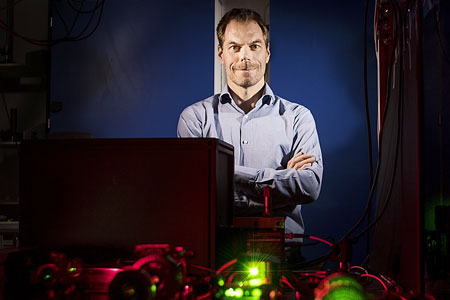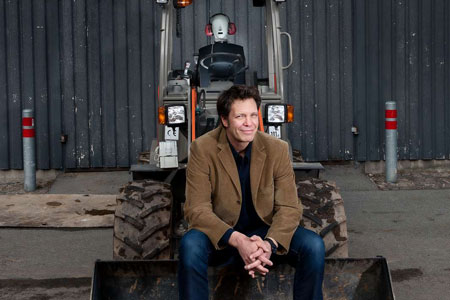Three grants from the Novo Nordisk Foundation will enable DTU researchers to create new knowledge about brain functions, gut bacteria, and nerve damage in the ears.
With a grant totalling EUR 6 million (DKK 45 million), the Novo Nordisk Foundation supports three DTU researchers and their health technology projects as part of the foundation’s Interdisciplinary Synergy Programme. The background for all three projects is that many health challenges and issues require solutions that cannot be found using a traditional professional approach alone.
The Novo Nordisk Foundation received 89 applications and has chosen to award grants to the three DTU professors Ulrik Lund Andersen, Anja Boisen, and Torsten Dau. They will each receive EUR 2 million (DKK 15 million) for their projects on brain functions, gut bacteria, and nerve damage in the ears, respectively.
“With the Synergy Programme, the Novo Nordisk Foundation wants to promote an innovative interdisciplinary research culture in Denmark that produces important academic synergies. The ambition is that by joining forces, the scientific outcome will be better than that achieved by the individual groups,” says Niels-Henrik von Holstein-Rahtlou, Head of Research & Innovation Grants, Novo Nordisk Foundation.
Biosensors to provide insight into brain functions
Professor Ulrik Lund Andersen, DTU Physics, has received funding for a project to develop a new method for obtaining new knowledge about the functions of brain and its inexplicable diseases. Together with his collaboration partners, he hopes to be able to develop biosensors through a new multidisciplinary research project that combines quantum physics and neurophysiology. The research group will develop new biosensors that utilize the unique magneto-optical characteristics of diamonds to acquire ultra-high sensitivity and resolution images.
"The ambition is that by joining forces, the scientific outcome will be better than that achieved by the individual groups."
Niels-Henrik von Holstein-Rahtlou, Novo Nordisk Foundation
“Despite many years of considerable academic effort, we still need a comprehensive understanding of how the brain works. In this project, we will develop new diamond sensors for high-resolution imaging of neurons in mouse brains and nerves in muscle tissue. The long-term vision is to use the new method to obtain new knowledge about the functions of the brain and its inexplicable diseases,” says Professor Ulrik Lund Andersen, DTU Physics.
Benign bacteria in the human body
In her research project, Professor Anja Boisen, DTU Nanotech, will focus on benign bacteria in the human body. An imbalance in the composition of the bacteria influences the development of a number of diseases, for example inflammation of the gut.
“Today, it is difficult to restore the bacterial composition of the gut once it is out of balance, and the methods used are not particularly effective. In our project, we will investigate a completely new method that in the long term will make it possible to restore the balance of the system by just taking a pill,” says Anja Boisen.
Measuring nerve damage caused by noise
In his research project, Professor Torsten Dau, DTU Electrical Engineering, wants to measure nerve damage in the ears in humans caused by noise exposure.
“Noise in our daily surroundings has been shown to result in nerve damage on the synapses in the inner ear, which cannot be measured in ordinary hearing tests. Our project combines MRI scanning technology with audiology and neurophysiology to establish methods for measuring this nerve damage and—in the long term—treat them,” he says.
Project title: “Interfacing emerging quantum technology with biology and neurophysiology.”

Grant recipient: Professor Ulrik Lund Andersen
Co-applicants: Professor Hartwig Siebner, Danish Research Centre for Magnetic Resonance, Hvidovre Hospital. Associate Professor Jean-Francois Perrier, Department of Neuroscience, University of Copenhagen. Associate Professor Axel Thielscher, Department of Electrical Engineering, Technical University of Denmark.
Project description
The human brain is a very complex system, the function of which we currently do not fully understand. A deeper understanding of the brain’s underlying principles is therefore one of the largest scientific challenges today.
In order to obtain greater knowledge about the brain, different imaging techniques are used today, but they all have low image resolution. The project will develop new diamond sensors for high-resolution imaging of neurons in mouse brains and nerves in muscle tissue. The long-term vision is to use the new method to obtain new knowledge about the functions of the brain and its inexplicable diseases.
Project title: “MIMIO - Microstructures, microbiota and oral delivery.”

Grant recipient: Professor Anja Boisen
Co-applicants: Professor Tine Rask Licht, DTU Food, Technical University of Denmark. Professor Willem Meindert Vos, Department of Agrotechnology and Food Sciences, Wageningen University, The Netherlands.
Project description
In the human body, there are a number of different benign bacteria which help to keep us healthy. In fact, bacterial cells outnumber human cells in the body. A large part of these bacteria live in our gut and have a large impact on our health. An imbalance in the composition of the bacteria influences the development of a number of diseases, for example inflammation of the gut.
At the moment, it is difficult to restore the bacterial composition in the gut once it is out of balance, and the methods being used are not particularly effective. The project will investigate a completely new method that in the long term will make it possible to restore the balance of the system by just taking a pill. The researchers place good bacteria in very small containers and investigate whether they—when consumed in a capsule—are able to deliver the bacteria to the right place and restore balance in the gut.
The group will examine how the small containers can be prepared and filled with bacteria and how they behave in cell and animal models.
Project title: “UHeal: Uncovering the Hidden Hearing Loss."

Grant recipient: Professor Torsten Dau
Co-applicants: Professor Hartwig Siebner, Danish Research Centre for Magnetic Resonance, Hvidovre Hospital. Professor Charles Liberman, Department of Otolaryngology, Massachusetts Eye and Ear Infirmary, Harvard Medical School.
Project description
We are increasingly exposed to noise in our everyday surroundings. Exposure to noise over longer periods may cause nerve damage in the inner ear, which—in particular—affects the ability to understand speech in noisy surroundings. The nerve damage cannot be measured in humans and is not identified by the clinical hearing tests used today. This ‘hidden hearing loss’ is probably widespread in the population, even among young people.
This international synergy project combines MRI scanning technology with audiology and neurophysiology to establish methods for measuring this nerve damage in humans. The project will develop scanning techniques to detect damage in the auditory nerve and investigate what consequences this nerve damage has on our hearing. This will make it possible to develop accurate diagnostics tools and thus better treatment options.